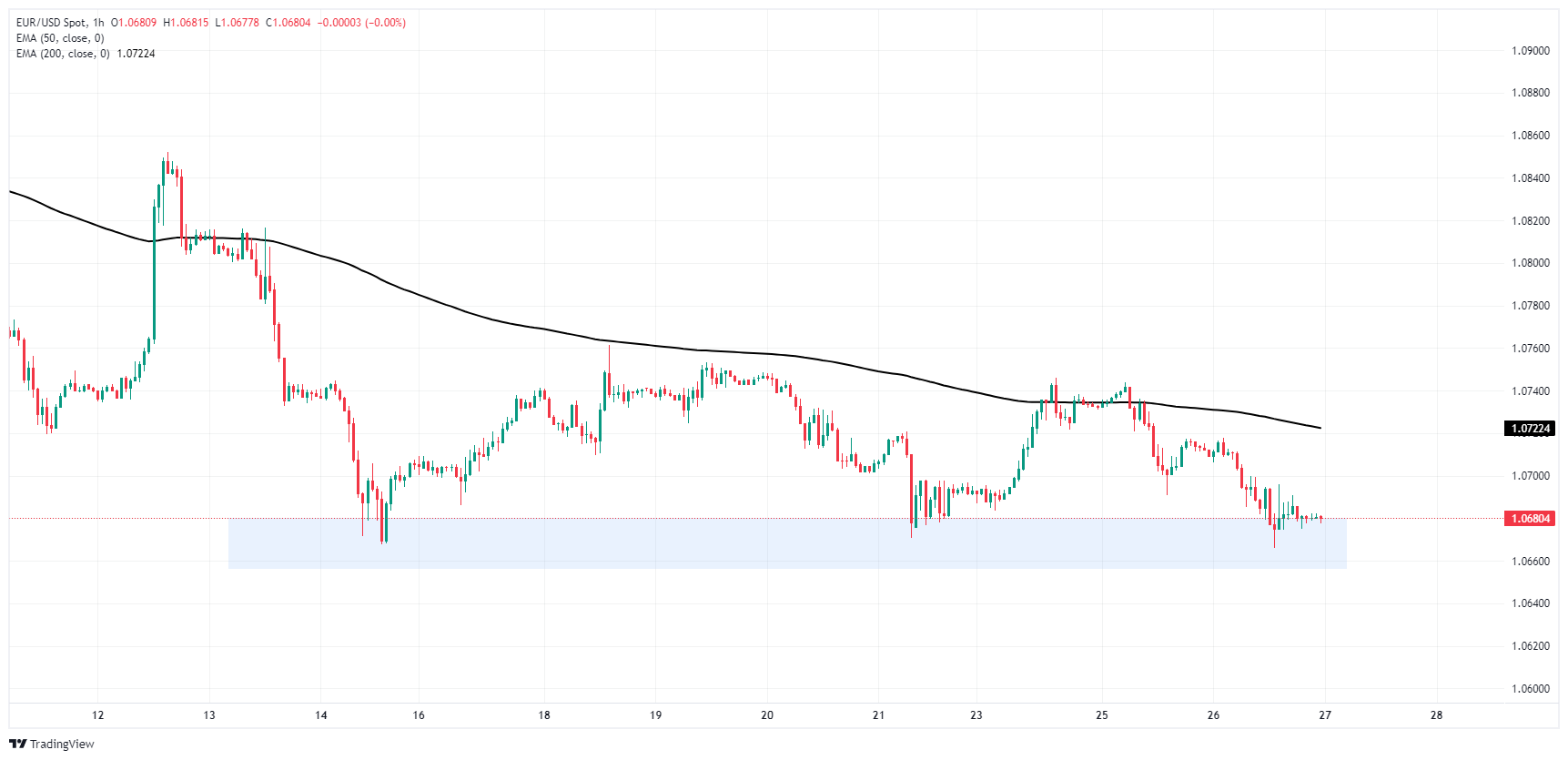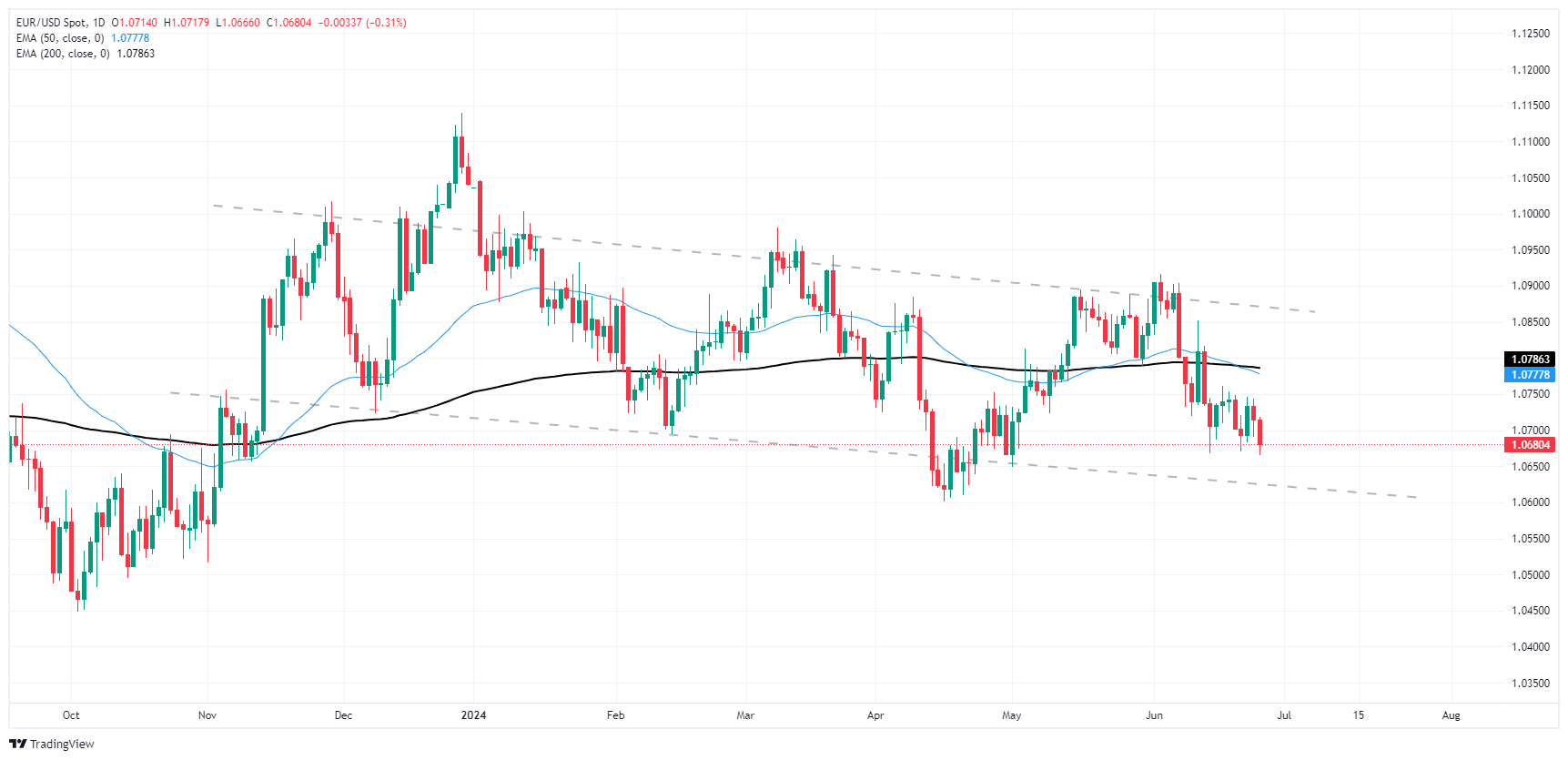EUR/USD pinned into low end below 1.0700 once again


- EUR/USD flubs the 1.0700 handle as bearish flows keep the Fiber pinned.
- Broad-market sentiment favored the Greenback on Wednesday as rate cut hopes dry up.
- Late-week key data prints to drive market momentum after an easy start to the week.
EUR/USD backslid into the 1.0680 region on Wednesday after the German GfK Consumer Confidence Survey for July ticked lower unexpectedly, and a lack of meaningful data during the American trading session left investors to chew on a cautious Federal Reserve (Fed) stance this week that saw rate cut bets shift lower.
Forex Today: Investors look at US PCE and French elections
German consumer confidence backslid to -21.8 for July, missing the forecast recovery to -18.9 from the previous month’s revised -21.0. Despite a slow and steady recovery in the German GfK Consumer Confidence Survey, Wednesday’s downside print kicked the legs out from beneath the already-battered Euro.
US New Home Sales Change in May clocked in a -11.3% decline MoM on Wednesday, compared to the previous month’s 2.0%, revised sharply from the initial print of -4.7%.
Confidence survey releases continue through Thursday, with pan-EU Business Climate, Consumer Confidence, and Economic Sentiment Indicator data points all slated for release during the European market window. US Durable Goods Orders, revisions to first-quarter Gross Domestic Product (GDP), and weekly Initial Jobless Claims will follow during Thursday’s American trading session.
US QoQ GDP is expected to tick upward slightly to 1.4% from the initial print of 1.3%, while May’s US Durable Goods Orders are expected to print a -0.1% contraction compared to the previous month’s revised 0.6%. US Initial Jobless Claims for the week ended June 21 are expected to tick slightly lower to 236K from the previous 238K, but the figure is expected to come in above the four-week average of 232.75K.
US Core PCE Price Index inflation is expected to tick down YoY to 2.6% from the previous 2.8% as market participants hope for further signs of easing inflation to help push the Federal Reserve (Fed) towards rate cuts sooner rather than later.
The market's confidence in a rate cut from the Federal Open Market Committee (FOMC) on September 18 has decreased. The probability of at least a quarter-point rate cut has decreased to around 60%, down from a peak of just above 70% last week, according to the CME’s FedWatch Tool.
Euro PRICE This week
The table below shows the percentage change of Euro (EUR) against listed major currencies this week. Euro was the strongest against the New Zealand Dollar.
| USD | EUR | GBP | JPY | CAD | AUD | NZD | CHF |
|---|---|---|---|---|---|---|---|---|
USD |
| 0.13% | 0.19% | 0.53% | 0.11% | -0.05% | 0.64% | 0.36% |
EUR | -0.13% |
| 0.07% | 0.48% | 0.05% | -0.15% | 0.55% | 0.30% |
GBP | -0.19% | -0.07% |
| 0.34% | -0.05% | -0.23% | 0.48% | 0.23% |
JPY | -0.53% | -0.48% | -0.34% |
| -0.43% | -0.54% | 0.16% | -0.17% |
CAD | -0.11% | -0.05% | 0.05% | 0.43% |
| -0.14% | 0.53% | 0.28% |
AUD | 0.05% | 0.15% | 0.23% | 0.54% | 0.14% |
| 0.71% | 0.46% |
NZD | -0.64% | -0.55% | -0.48% | -0.16% | -0.53% | -0.71% |
| -0.26% |
CHF | -0.36% | -0.30% | -0.23% | 0.17% | -0.28% | -0.46% | 0.26% |
|
The heat map shows percentage changes of major currencies against each other. The base currency is picked from the left column, while the quote currency is picked from the top row. For example, if you pick the Euro from the left column and move along the horizontal line to the US Dollar, the percentage change displayed in the box will represent EUR (base)/USD (quote).
EUR/USD technical outlook
Intraday action continues to get squeezed between the 200-hour Exponential Moving Average (EMA) at 1.0722 and a supply zone baked in below 1.0680. The Fiber is poised for a fresh decline into new near-term lows below 1.0660 if buyers aren’t able to shake off a pattern of descending highs.
A rough descending channel is keeping daily candlesticks tilted towards the downside, and price action continues to waffle on the south side of the 200-day EMA at 1.0796. A last bearish push to 1.0600 could see a bullish bounce back towards chart territory north of 1.0700, while a continuation will see EUR/USD chalk in fresh lows for 2024.
EUR/USD hourly chart

EUR/USD daily chart






